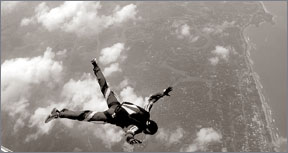CFA transformed Lankan polity
 A pathetic state of affairs, indeed, for an agreement which once
looked so promising. But, five years since it came into effect, the
Ceasefire Agreement is almost defunct. A pathetic state of affairs, indeed, for an agreement which once
looked so promising. But, five years since it came into effect, the
Ceasefire Agreement is almost defunct.
The latest statistics of the loss of lives during the five years of
the ceasefire agreement make a mockery of the ceasefire itself. 1156
security forces personnel, 944 civilians and approximately 2250 LTTE
cadres have been killed during the last five years.
Understandably, the last year was the bloodiest and the spiralling
violence in the North and the East, and sporadic terror attacks in the
South, made the former Head of the Mission of the Scandinavian truce
monitors, Trond Furuhovde, declare that the ceasefire was "only in the
paper."
|

Thirty four army commandos who completed the parachute training
course passed out on Friday at the Katukurunda Air Field. Our
photographer Sudath Nishantha captured this action 15,000 feet above
the ground. |
But, if the sporadic clashes in the first years of the CFA were a
cause for disappointment, the developments in the past year overshadowed
by open and high intensity confrontations between the Security Forces
and the LTTE, ridiculed the very idea of the ceasefire agreement.
Covert and overt attacks
The LTTE strategy, throughout the ethnic insurgency, was to force the
government in to submission through covert and overt attacks. The
behavioral conduct of Tiger chieftain, Velupillai Prabhakaran, at the
very outset of the ceasefire, indicate that he did not want to divert
from that strategy, even during the truce agreement.
The covert war, which was waged for the first four years of the
ceasefire suddenly became an open armed confrontation with the election
of President Mahinda Rajapaksa, viewed by the Tigers as a hardliner.
Barely two weeks in to his Presidency, Rajapaksa was greeted with a
string of claymore mine explosions which killed scores of soldiers and
sailors.
Operation Watershed, dubbed as a humanitarian mission which is the
first major security forces offensive during the ceasefire was launched
after the Tigers closed sluice gates of Mavilaru anicut.
The security forces top brass in the East, who debriefed several LTTE
cadres, who surrendered - or were arrested-during their retreat from
Vakarai, last month, are now convinced of what would have been the LTTE
strategy in closing the Mavilaru anicut.
The arrested Tiger cadres, who were earlier deployed in Mavilaru,
where the Tigers set up trenches to fight a prolonged battle with the
forces, have allegedly confessed that the closure of the sluice gates
were intended to provoke the troops for a confrontation.
Why provoking the troops for a fight, rather than launching a
surprise attack? Senior Army official said the Tigers were concerned of
international opinion. The LTTE wanted an excuse to justify a greater
offensive to capture the Southern perimeters of Trincomalee harbour.
The Tigers succeeded in the first phase of the strategy. The security
forces launched an operation to open sluice gates.
The LTTE strategy was to provoke the security forces to attack the
LTTE positions, which were well entrenched at that time, and using this
as a justification, to attack and capture the Muttur jetty and the
Kattaparichchan military outpost.
In line with the plan, the Tigers launched a surprise pre-dawn
attack, simultaneously at four security forces camps, which included,
Mahindapura, PahalaThopur, Muttur and Kattaparichchan.
The greater weight was put on Kattaparichchan, the collapse of which
would have made the Tigers the controllers of the entire southern
perimeters of the strategically important Trincomalee harbour.
However, the attack was a fatal miscalculation. What the Tigers did
not pay attention was that, by the time they attacked the four military
outposts, tactical headquarters of the security forces in the East had
been relocated to the Kallar Army Camp to facilitate the security forces
operations in Mavil Aru.
So there were artillery guns, MBRL and troops and other logistics
nearby for the rapid deployment.
Officers and Soldiers fought valiantly; a young captain with his 80
odd troops fought five hundred LTTE cadres who laid seige to the camp
for four days.
But, it must be admitted that the rapid dispatch of reinforcement
troops and weapon systems were also instrumental in beating back the
Tigers.
Then the Tigers shifted the theatre of the battle and opened a new
front in the North, having launched an offensive to overrun the security
forces Forward Defence Lines in Muhamalai and Nagarkovil.
That was proved to be a costly offensive and 171 soldiers and 16
officers were killed in fighting during August 11-26. 49 officers and
840 soldiers were wounded, most of them classified as walking wounded.
Over 700 LTTE cadres were believed to be killed during the same period.
Costly offensive
Later a Tiger suicide bomber blew himself up targeting a convoy of
sailors bound home, killing over 120.
A security forces operation to stretch its Northern FDL was proved to
be extremely costly in the late October which cost the lives of 128
soldiers and officers.
The security forces captured Sampur to neutralise the regular suicide
sea Tiger attacks originated from their launching pads in Soodaikudai
and Illankantai. On January 19, troops captured Vakarai.
Developments in the last year confined the ceasefire to its paper.
But, at its outset, the ceasefire was a cause for a greater optimism.
Five years ago, this week, then Premier Ranil Wickremesinghe penned
his signature in the MoU during a much publicized visit to Vavuniya,
accompanied by then Norwegian Ambassador Jon Westberg.
The CFA was seen as the corner- stone of the peace process. And it
was the culmination of two months of behind the curtain deliberations by
the Norwegians, Sri Lankan Government and the LTTE.
The Ceasefire Agreement was not flawless, but it succeeded halting
fighting which bled the island for nearly two decades. However, what is
important to note is more than technical details, it was the sincerity
and commitment of the two signatories that mattered for the successful
implementation of the agreement.
Soon, the strains of the CFA were evident as the objectives of the
two parties to the agreement turned to be different, and to a certain
degree, incompatible.
The Wickremesinghe Administration invested its whole political future
on the peace project. Whereas the Tiger chieftain, Velupillai
Prabhakaran, true to his pledge to never give up the fight for an 'Eelam"
launched a covert war against the intelligence operatives and rival
Tamil political activists.
Soon, frictions were apparent on the ceasefire. What however
prevented an early confrontation was the absence of political will of
the Wickremesinghe and, later, Kumaratunga Administration. Another
school of thought, however, the Wickremesinghe Administration planning a
greater scheme to lock the Tigers in the peace process, believed that it
was not worth the cost to engage in a new confrontation.
International safety net
Its strategy, reinforced by an international safety net was to force
the Tigers towards democratic politics.
The then President Chandrika Kumaratunga compelled by her senior
party members rocked the peace boat, but, she restrained herself from
retaliatory attacks against the Tigers, despite the latter killing her
Foreign Minister. After all the success of the entire process is
dependent on the sincerity of the two signatories.
Despite its initial achievements, the CFA was cause for controversy,
initially, over the secrecy in which it was formulated and signed, even
without the knowledge of the members of the then Cabinet, barring a few
members of Wickremesinghe's inner circle.
Another loophole of the CFA was the absence of an enforcement
mechanism. The Scandinavian truce monitors - invited by the Government,
with the hope, that the presence of the international community would
dissuade ceasefire violations - found themselves powerless.
The integrity of the truce monitors was also questioned by the
country's nationalist elements, who, to be frank, were against the peace
process from its very outset.
The question is to what extent the CFA could deliver on its
expectations.
Even though the extremes of both sides would not like to accept it,
the Ceasefire Agreement transformed the Sri Lankan polity, both in the
North and South. Of course it could not live up to its full
expectations, but its achievements, at least during the past four years
are remarkable. Freedom of movement allowed by the article 2.10 of the
Ceasefire Agreement is the impetus for economic revival of the
North-East. Of course, the CFA did not produce an economic miracle in
the Wanni.
But, it was the basis of the socio-economic progress in the
North-East.
According to the "Sri Lanka Poverty Assessment," of the World Bank
Gross Domestic Product growth in the North quadrupled and that of the
East doubled during the ceasefire years.
Downward trend in unemployment continued in both provinces, with the
rate of unemployment in the North dropping from 13 to 9 and that of the
East falling from 16 to ten percent during 2002-2004.
However the recent outbreak of an open war and the closure of the
entry-exit point in Muhamalai would dampen the growth prospects in the
two provinces.
A revised research report on the "Economic, Socio-political and Human
costs of the war in Sri Lanka," published by the National Peace Council
and the Marga Institute estimates the economic costs of the war to be a
staggering 2,451 billion rupees.
The report breaks up the total cost into sub categories such as
direct expenditure on defence by the Government which amounts 372.78
billion rupees, additional spending on public order and safety (63.12
billion rupees),Government expenditure on needs of refugees and
displaced (53 billion), damage to infrastructure and property (230.9
billion), loss of tourism and foreign investment (366 billion), loss of
economic output in the North-East (413 billion) and loss of income due
to migration of professionals (191.37 billion) and defence expenditure
by the LTTE which is estimated at least 20 per cent of the Government's
defence spending i.e, at least 74.55 billion rupees. According to the
report, two-thirds of total economic cost was borne by the North and
East.
It is no longer a cause for euphoria as the ceasefire marks its fifth
anniversary. The very notion of a ceasefire is ridiculed by the regular
clashes between the government and the LTTE. Now, the challenge is
salvaging the ceasefire agreement. Because, abandoning it to have a
natural death would be a cause to a greater disaster.
[email protected]
|
